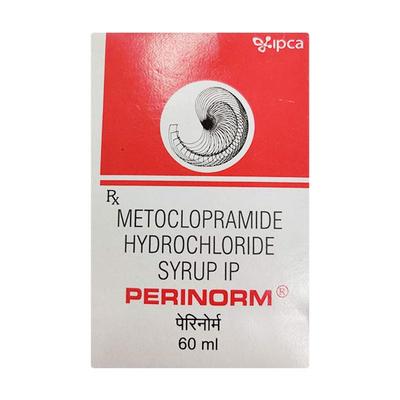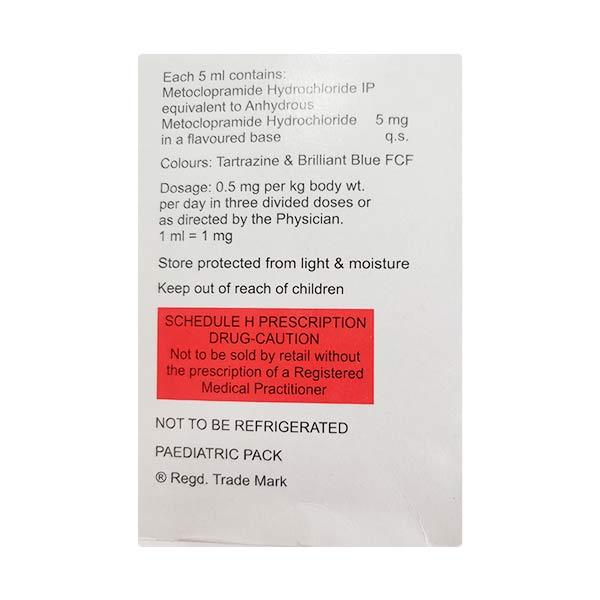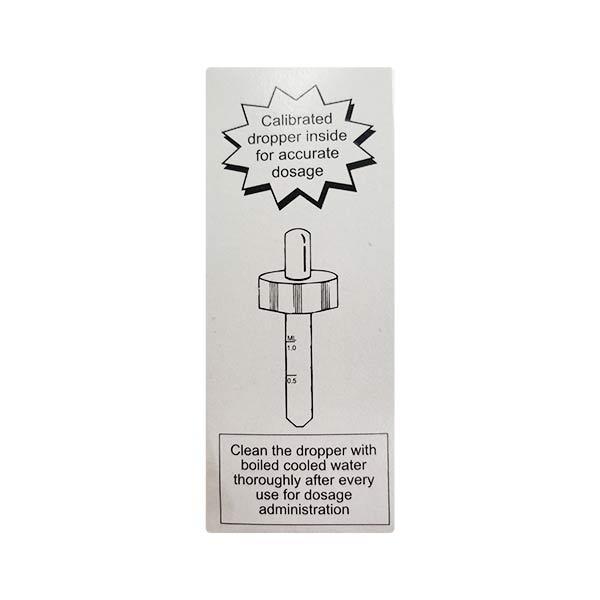

Netmeds First Membership
Quick Links
Introduction About PERINORM SYRUP
PERINORM SYRUP contains Metoclopramide which belongs to the group of medicines called Anti-emetics. It is used to manage delayed nausea and vomiting in children (aged 1 to 18 years, when other medicines do not work or cannot be used to manage it) and adults that may occur after chemotherapy. PERINORM SYRUP is also used in adults to manage nausea and vomiting caused by radiotherapy and manages nausea and vomiting which may occur with a migraine.
Migraine is a headache which causes severe throbbing pain or pulsing sensation, particularly on one side of the head and it is characterized by symptoms such as nausea, vomiting and sensitivity to light. PERINORM SYRUP can also be taken with oral painkillers in case of migraine to make painkillers work more effectively.
Your doctor may perform blood tests during the management to monitor your blood pigment (haemoglobin) levels. Your doctor may immediately or permanently stop your management if there are any abnormalities in the levels of blood pigment.
PERINORM SYRUP is not recommended for use in patients with epilepsy, parkinson’s disease, bleeding, obstruction or tear in the stomach or gut, tumour of adrenal gland (pheochromocytoma) and involuntary muscle spasms (due to other medicines).
PERINORM SYRUP should be used with caution in pregnant women only if clearly advised by the doctor and it is not recommended for use in breastfeeding women as it may pass through the breast milk.
PERINORM SYRUP is not recommended for use in children (below 1 year of age) and should be used with caution in children and adolescents (aged 1 to 18 years). PERINORM SYRUP should be used with caution in elderly patients. Consult your doctor before taking it.
The most common side effects of taking PERINORM SYRUP are drowsiness, restlessness, feeling weak, uncontrollable body movements (such as muscle stiffness or rigidity) and diarrhoea. Consult your physician immediately if any of the side effects worsen.
Uses Of PERINORM SYRUP
- Prevents delayed nausea and vomiting that occurs after chemotherapy (in children (aged 1 to 18 years) and adults)
- Prevents nausea and vomiting caused by radiotherapy
- Manage nausea and vomiting that may occur with migraine
How PERINORM SYRUP Works
PERINORM SYRUP acts and supresses certain centres called dopamine (brain chemical) centres by decreasing the sensitivity of the nerves that transmit signals from gastrointestinal tract to the vomiting centres in the brain. It also relaxes the muscles of stomach and enhances the motility of gut and manages nausea and vomiting.
How to use PERINORM SYRUP
Take PERINORM SYRUP as advised by your physician. Shake well before use. Use a measuring cup or a spoon to properly measure the dose. Your doctor will determine the correct dose and duration for you depending on your age, body weight and disease condition.
Side Effects Of PERINORM SYRUP
Common
- drowsiness
- uncontrollable movements such as shaking, tics, twisting movements or muscle contracture (stiffness, rigidity)
- rigidity and tremor (similar to Parkinson’s disease)
- diarrhoea
- feeling weak
- restlessness
Uncommon
- elevated levels of hormone called prolactin (which may cause milk secretion in men and women who are not breastfeeding)
- irregular periods
- hallucination
- reduced consciousness
- allergy
- visual problems and involuntary deviation of eyeball
Rare
- confusional state
- convulsions (especially in patients with fits)
Stop taking PERINORM SYRUP and contact your doctor immediately if you experience any of the following side effects:
- signs of severe allergic reactions (such as swelling of the face, lips, tongue, throat and difficulties in breathing)
- signs of a brain disorder called neuroleptic malignant syndrome (such as sweating, high fever, high blood pressure, convulsions and production of saliva)
- uncontrollable movements of head and neck (occurs in children or young adults)
How To Manage Side Effects
Diarrhoea:
Drink lot of fluids such as water or fruit juice to keep yourself hydrated. Avoid eating high-fat or spicy foods. Do not take any medicine on your own to manage diarrhoea without consulting your doctor.
Feeling weak:
Drink plenty of fluids and eat a balanced diet and frequent meals. Do regular minimal exercise (such as walking) and follow a regular sleep schedule. Consult your doctor if the symptom does not improve.
Warning & Precautions
Pregnancy
PERINORM SYRUP should be used with caution in pregnant women or women who are planning to become pregnant only if clearly advised by your doctor. Consult your doctor before taking it.
Breastfeeding
PERINORM SYRUP is not recommended for use in breastfeeding women as it may pass through the breast milk and affect the baby. Consult your doctor before taking it.
Driving and Using Machines
Do not drive or operate any machines if you feel dizzy, drowsy or have uncontrollable twitching, jerking or writhing movements and unusual muscle tone leading to distortion of the body or your vision gets affected after taking PERINORM SYRUP.
Alcohol
Avoid consumption of alcohol while taking PERINORM SYRUP because it may increase the effect of sleepiness and drowsiness.
Kidney
PERINORM SYRUP should be used with caution in patients with kidney problems. Lower doses may be given to patients having moderate or severe kidney problems. Consult with your doctor before taking PERINORM SYRUP.
Liver
PERINORM SYRUP should be used with caution in patients with liver problems. Lower doses may be given to patients having severe liver problems. Consult with your doctor before taking PERINORM SYRUP.
Allergy
Do not take PERINORM SYRUP if you are allergic to Metoclopramide or any of its constituents.
Heart Disease
PERINORM SYRUP should be used with caution in patients having heart diseases such as history of abnormal heart beats (QT interval prolongation, seen in an ECG) or any other heart problems. Consult with your doctor before taking PERINORM SYRUP.
Others
PERINORM SYRUP is not recommended for use if you:
- have bleeding, obstruction or a tear in your stomach or gut
- have or may have a rare tumour of adrenal gland called pheochromocytoma
- have ever had involuntary muscle spasms (when managed with any medicine in the past)
- have epilepsy (seizures or fits)
- have parkinson’s disease (brain disorder causing uncontrollable movements of the body)
- have abnormal levels of blood pigments (methemoglobinemia or NADH cytochrome b5 deficiency)
Before taking PERINORM SYRUP, inform your doctor if you:
- have problems with the levels of salts in the blood such as potassium, sodium or magnesium
- have any brain problems
Use in paediatrics:
PERINORM SYRUP is not recommended for use in children (below 1 year of age) because of the increased risk of uncontrollable movements. PERINORM SYRUP should be used with caution in children and adolescents (between age of 1 to 18 years) to manage delayed nausea and vomiting after chemotherapy. Your child’s doctor may adjust the dose depending on the child’s age and body weight. Consult your child’s doctor for advice.
Use in geriatrics:
PERINORM SYRUP should be used with caution in elderly patients and your doctor may adjust the dose depending on kidney and liver function and overall health condition. Consult your doctor before taking it.
Interactions
A. Drug - Drug interactions:
Before taking PERINORM SYRUP, inform your doctor if you have received or taking any of the following medicines:
- medicines used to manage a brain disorder called Parkinson’s disease (Ex. levodopa, carbidopa, entacapone, tolcapone)
- anticholinergics (medicines used to manage stomach cramps and spasms) Ex. dicyclomine, hyoscyamine
- morphine derivatives (medicine used to manage severe pain) Ex. oxycodone, oxymorphone
- sedative medicines (used to manage sleeping disorders, anxiety or panic attacks) Ex. diazepam, lorazepam
- chlorpromazine, carbamazepine, lithium (used to manage mental health problems)
- medicines used to manage depression (Ex. fluoxetine, paroxetine)
- medicine used to manage heart failure (Ex. digoxin)
- ciclosporin (medicine used during organ transplant to avoid organ rejection)
- mivacurium and suxamethonium (medicines used to relax the muscles)
Overdosage:
If you or anyone else accidentally take too much of PERINORM SYRUP, consult your doctor immediately or visit the nearby hospital. Symptoms of overdose are uncontrollable movements, feeling drowsy, troublesome consciousness, confusion, hallucinations and heart problems.
Synopsis
| Drug | : | Metoclopramide |
| Pharmacological Category | : | Anti-emetics |
| Therapeutic Indication | : | Prevents and manages nausea and vomiting |
| Dosage Forms | : | Tablet, Capsule, Syrup, Injection |
More Information
- Keep out of the sight and reach of children.
- Store PERINORM SYRUP at room temperature below 25°C
FAQs About PERINORM SYRUP
What is PERINORM SYRUP and why is it prescribed?
PERINORM SYRUP contains Metoclopramide which belongs to the group of medicines called Anti-emetics. It is used to manage delayed nausea and vomiting in children (aged 1 to 18 years, when other medicines do not work or cannot be used to manage it) and adults that may occur after chemotherapy. PERINORM SYRUP is also used in adults to manage nausea and vomiting caused by radiotherapy and manages nausea and vomiting which may occur with a migraine. PERINORM SYRUP can also be taken with oral painkillers in case of migraine to make painkillers work more effectively.
What are the common side effects of PERINORM SYRUP?
The most common side effects of taking PERINORM SYRUP are drowsiness, uncontrollable movements of the body (such as shaking, tics, twisting movements or muscle stiffness or rigidity), tremor and rigidity similar to parkinson’s disease, restlessness, diarrhoea and feeling weak. Consult your doctor immediately if you experience any of these side effects.
Can PERINORM SYRUP be used in patients with kidney disease?
PERINORM SYRUP should be used with caution in patients with kidney problems. Your doctor may adjust the dose to the lowest effective dose in patients with moderate or severe kidney problems. Consult with your doctor before taking PERINORM SYRUP.
Can I drive or operate machines after taking PERINORM SYRUP?
Do not drive or operate any machines if you feel dizzy, drowsy or have uncontrollable twitching, jerking or writhing movements and unusual muscle tone leading to distortion of the body or your vision gets affected after taking PERINORM SYRUP. Consult your doctor for advice before taking PERINORM SYRUP.
Is PERINORM SYRUP safe to use during pregnancy?
PERINORM SYRUP should be used with caution during pregnancy only if clearly advised by your doctor. Consult your doctor before taking PERINORM SYRUP if you are pregnant or planning to get pregnant.
Can PERINORM SYRUP be used in children?
PERINORM SYRUP is not recommended for use in children (below 1 year of age) because of the increased risk of uncontrollable movements. PERINORM SYRUP should be used with caution in children and adolescents (between age of 1 to 18 years) to manage delayed nausea and vomiting after chemotherapy. Your child’s doctor may adjust the dose depending upon child’s age and body weight. Consult your child’s doctor for advice.
References
1. KD Tripathi. Antiemetic, Prokinetic and Digestant Drugs. Essentials of Medical Pharmacology. Eighth Edition. 2019. Page – 713.
2. Keith Kleinman. Metoclopramide. Science Direct. 2021. [Accessed on 3rd August 2022] https://www.sciencedirect.com/topics/medicine-and-dentistry/metoclopramide
3. Sasank Isola, Azhar Hussain, Anterpreet Dua, Karampal Singh and Ninos Adams. Metoclopramide. NIH. National Library of Medicine, National center for biotechnology information. April 2022 [Accessed on 3rd August 2022] https://www.ncbi.nlm.nih.gov/books/NBK519517/
4. Cox, R., Newman, C.E. and Leyland, M.J. Metoclopramide in the reduction of nausea and vomiting associated with combined chemotherapy. Springer Link. April 1982. [Accessed on 3rd August 2022] https://link.springer.com/article/10.1007/BF00292884#citeas
5. Rosemont Pharmaceuticals Ltd. Electronic Medicines Compendium (EMC). [Revised in May 2020] [Accessed on 3rd August 2022] https://www.medicines.org.uk/emc/product/1561/pil
6. SyriMed. Electronic Medicines Compendium (EMC). [Revised in July 2021] [Accessed on 3rd August 2022] https://www.medicines.org.uk/emc/files/pil.2471.pdf
Useful Diagnostic Tests
- Complete blood count










